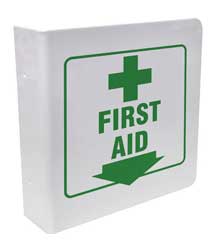



Find all of your laboratory and workplace safety supplies at Safety Emporium!
 Cyanide |
 Glossary Index |
 Cytotoxin |
| MSDS Topics |
Free Sites | FAQ's | Regulations | Glossary | Software | Suppliers |
| Books | Forum | Poll | Fun stuff | Quiz | Store | |
| Understand your MSDS with the MS-Demystifier | Search ALL our MSDS info | |||||

We have all kinds of safety wall signs at Safety Emporium.
The bluish (cyan) or blue-gray color arises from deoxygenated hemoglobin, the oxygen carrier in your bloodstream that carries oxygen from your lungs to your tissues. Hemoglobin and your blood are red when well-oxygenated, but blood appears to be dark red-blue if there is more than 50 g/L of hemoglobin without oxygen.
Cyanosis can be seen in cases of anoxia and hypoxia (lack of oxygen) and is a symptom of asphyxiation. Medical conditions that involve diminished transport of oxygen in the body (heart disease, emphysema, pulmonary embolism, hypothermia etc.) can also cause cyanosis.
Cyanosis is also observed when a chemical agent blocks the ability of hemoglobin to bind oxygen. For example, carbon monoxide, CO, a product of incomplete combustion, binds to hemoglobin approximately 200 times better than oxygen. Victims of carbon monoxide poisoning often have blue lips and fingernails.
Treatment for cyanosis includes administration of pure oxygen. In the case of carbon monoxide poisoning, hyperbaric oxygen treatment, placing the victim in a chamber pressurized to 2 or 3 atmospheres of pure oxygen, may be used.
Cyanosis is harder to observe in dark-skinned people. The best places to look in this case are in the buccal mucosa (inside of the cheek) and hard palate (roof of the mouth).
Cyanosis gets its name from the color cyan, which is a greenish blue, not from the symptoms of cyanide poisoning. While cyanide poisoning does interfere with the body's handling of oxygen, its mechanism of action involves cytochrome oxidase rather than hemoglobin.
Cyanosis typically appears as a symptom of exposure or sign to watch for in sections Section 4 (first-aid measures) as well as Section 11 (toxicological information) of relevant Safety Data Sheets.
Cyanosis is an early sign of hypoxia. If you are working in a confined space where the oxygen content may be less than normal or are working with a chemical substance that interferes with oxygen transport in the body, be sure to recognize the bluish cast of cyanosis.
When working with substances that can cause cyanosis, be sure that all workers are properly trained and that appropriate first aid is available.

We have all kinds of first aid signs, posters and labels at Safety Emporium.
See also: anoxia, asphyxiant, cyanide, hypoxia.
Additional definitions from Google and OneLook.
Entry last updated: Saturday, July 9, 2022. This page is copyright 2000-2025 by ILPI. Unauthorized duplication or posting on other web sites is expressly prohibited. Send suggestions, comments, and new entry desires (include the URL if applicable) to us by email.
Disclaimer: The information contained herein is believed to be true and accurate, however ILPI makes no guarantees concerning the veracity of any statement. Use of any information on this page is at the reader's own risk. ILPI strongly encourages the reader to consult the appropriate local, state and federal agencies concerning the matters discussed herein.